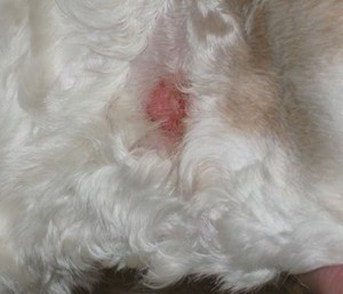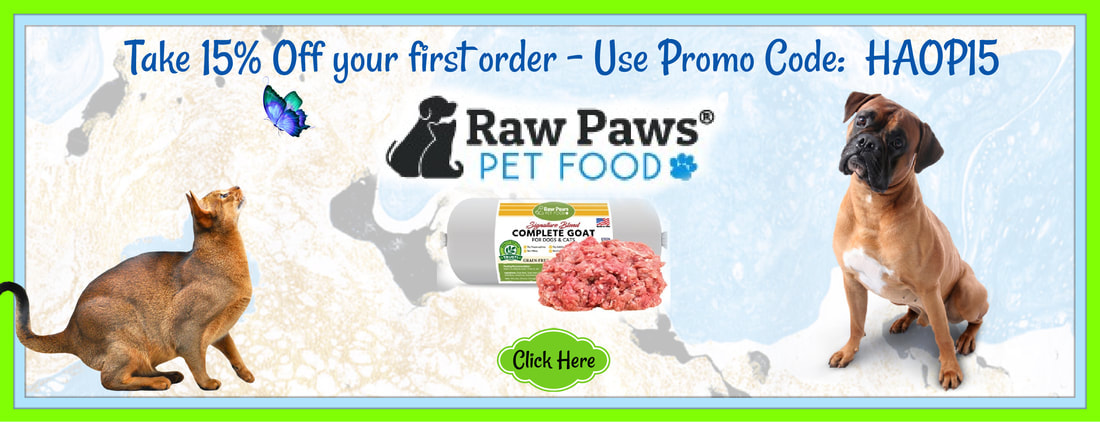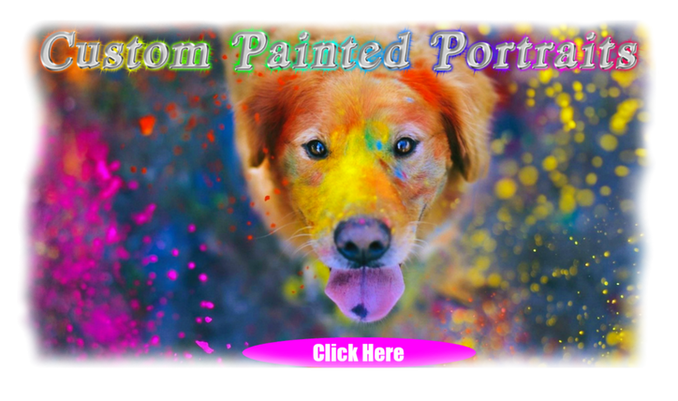What is a "hot spot"?

Dr. Becker's Comments:
Hot spots are also known as pyotraumatic dermatitis or superficial pyoderma. Those tongue-twisters are just scientific labels for inflamed, infected skin.
How Hot Spots Develop
Hot spots are created when your dog’s natural bacteria overpopulates parts of his skin. When an infection arises from a dog’s own bacteria, there is almost always a root cause. Hot spots often occur in dogs with underperforming immune systems.
Hot spots can come on very quickly. You might leave your perfectly healthy pup one morning to go to work, and by the time you return home that evening, she’s completely preoccupied with an area of skin that is irritated, inflamed and oozing. Hot spots can be very painful for your dog and quite sensitive to the touch.Any dog can develop hot spots, but they’re much more common in dogs with thick coats, dirty and/or moist skin, and dogs with allergies, including fleas.
Let’s say your dog jumps into a pond of dirty water on a hot, humid summer day, then gets out and lays in the grass under a tree for a nap.
Hot spots are also known as pyotraumatic dermatitis or superficial pyoderma. Those tongue-twisters are just scientific labels for inflamed, infected skin.
How Hot Spots Develop
Hot spots are created when your dog’s natural bacteria overpopulates parts of his skin. When an infection arises from a dog’s own bacteria, there is almost always a root cause. Hot spots often occur in dogs with underperforming immune systems.
Hot spots can come on very quickly. You might leave your perfectly healthy pup one morning to go to work, and by the time you return home that evening, she’s completely preoccupied with an area of skin that is irritated, inflamed and oozing. Hot spots can be very painful for your dog and quite sensitive to the touch.Any dog can develop hot spots, but they’re much more common in dogs with thick coats, dirty and/or moist skin, and dogs with allergies, including fleas.
Let’s say your dog jumps into a pond of dirty water on a hot, humid summer day, then gets out and lays in the grass under a tree for a nap.
|
This activity has created a dirty, damp, warm, very hospitable environment for your dog’s natural skin bacteria to overgrow. It’s a set-up for a potential full body allergic reaction, including multiple hot spots, on your pet’s skin.
If your canine companion develops a hot spot, you’ll need to do two things:
|
Treating Hot Spots
Hair removal. To treat the wound, the first thing you need to do is remove the hair on, in and around the affected area.
You may not want to do that, because, for example, you show your dog in the ring.
But if you don’t remove the hair, it will become trapped in the wound by the pus and you’ll have a much harder time healing the hot spot. In fact, hair in and around the affected area can create a perfect environment for the wound to get bigger and the infection to get worse.
I recommend you shave the area of the hot spot, and then mark the edges of the lesion with a Sharpie type pen so you can tell if the infection is expanding.
Hair removal. To treat the wound, the first thing you need to do is remove the hair on, in and around the affected area.
You may not want to do that, because, for example, you show your dog in the ring.
But if you don’t remove the hair, it will become trapped in the wound by the pus and you’ll have a much harder time healing the hot spot. In fact, hair in and around the affected area can create a perfect environment for the wound to get bigger and the infection to get worse.
I recommend you shave the area of the hot spot, and then mark the edges of the lesion with a Sharpie type pen so you can tell if the infection is expanding.
If the infection appears to be spreading, you know you’re not treating it effectively at home and you should get your pup to your veterinarian as soon as possible.
Some hot spots can result in fever and serious underlying skin problems, so if you see the wound growing rather than improving after a couple of days, it’s time to seek veterinary care.
Some hot spots can result in fever and serious underlying skin problems, so if you see the wound growing rather than improving after a couple of days, it’s time to seek veterinary care.
Disinfecting the wound. Once you’ve shaved the area and identified the margins, clip the hair back until you see healthy skin. Then you can begin gently disinfecting the wound with a solution that will remove bacteria.
I recommend using povidone-iodine, which is often sold by the brand name Betadine. It’s an organic iodine with has no side effects and does a good job controlling most skin bacteria. You can buy povidone-iodine at most pharmacies and some health food stores.
Dilute the solution with purified water until it’s the color of iced tea. Apply it to the wound using a soft wash cloth or gauze.
In the beginning – at least days one and two of the disinfecting routine – while there’s a lot of oozing from the wound, you’ll want to repeat the disinfecting procedure as often as necessary to keep the area clean, dry and pus free.
Your goal in managing your pup’s hot spot is to keep the area clean and dry at all times, so the first couple days you might need to disinfect the wound as often as every two hours.
Depending on the severity of the infection and the amount of pus the wound is producing, disinfecting two times a day should be an absolute minimum. Remember – a consistently clean and dry wound is critical to healing the infection.
I recommend using povidone-iodine, which is often sold by the brand name Betadine. It’s an organic iodine with has no side effects and does a good job controlling most skin bacteria. You can buy povidone-iodine at most pharmacies and some health food stores.
Dilute the solution with purified water until it’s the color of iced tea. Apply it to the wound using a soft wash cloth or gauze.
In the beginning – at least days one and two of the disinfecting routine – while there’s a lot of oozing from the wound, you’ll want to repeat the disinfecting procedure as often as necessary to keep the area clean, dry and pus free.
Your goal in managing your pup’s hot spot is to keep the area clean and dry at all times, so the first couple days you might need to disinfect the wound as often as every two hours.
Depending on the severity of the infection and the amount of pus the wound is producing, disinfecting two times a day should be an absolute minimum. Remember – a consistently clean and dry wound is critical to healing the infection.
Applying a topical solution. After you clean the wound you can apply a topical solution like colloidal silver, or raw aloe, or a thin layer of manuka honey, which is a raw honey made from the tea tree plant. You can also use a cool chamomile tea bag against the wound to provide a soothing effect.
Don’t use anything with stinging or astringent properties on an open, raw wound. Solutions like vinegar or tea tree oil, while anti-microbial, are really painful when applied to an open, raw wound, so I don’t recommend you use those types of aggressive solutions when you are treating an infected hot spot.
Repeat the disinfecting procedure and application of a light, natural topical soothing gel afterwards until the wound shrinks in size, the infection clears and your pet is no longer bothered by the hot spot.
Keeping your dog away from the wound. Insuring your pet leaves the hot spot alone is critical to healing. You’ll probably need to put an E collar on her (one of those lampshade shaped collars that are so annoying to pets) to prevent her from licking and biting the affected skin.
Don’t use anything with stinging or astringent properties on an open, raw wound. Solutions like vinegar or tea tree oil, while anti-microbial, are really painful when applied to an open, raw wound, so I don’t recommend you use those types of aggressive solutions when you are treating an infected hot spot.
Repeat the disinfecting procedure and application of a light, natural topical soothing gel afterwards until the wound shrinks in size, the infection clears and your pet is no longer bothered by the hot spot.
Keeping your dog away from the wound. Insuring your pet leaves the hot spot alone is critical to healing. You’ll probably need to put an E collar on her (one of those lampshade shaped collars that are so annoying to pets) to prevent her from licking and biting the affected skin.
If your pup continues to re-traumatize the wound, the infection won’t clear up and the hot spot will get bigger.
As an alternative to the E collar, you might be able to manage the wound by applying a light wrap or putting a t-shirt on your pet, as long as you are sure she is leaving the wound alone.
Finding the Root Cause of Your Pet’s Hot Spot
The second step in managing hot spots is to identify why they happen.
Allergic sensitivity. Allergies, both food and environmental, can cause hot spots. If you notice that each time your dog eats a bit of your wheat bread crust she gets a hot spot, there’s a very good chance she has a grain-based allergy. If that’s the case, you’ll want to evaluate the content of the food you feed your pet and make adjustments as necessary.
As an alternative to the E collar, you might be able to manage the wound by applying a light wrap or putting a t-shirt on your pet, as long as you are sure she is leaving the wound alone.
Finding the Root Cause of Your Pet’s Hot Spot
The second step in managing hot spots is to identify why they happen.
Allergic sensitivity. Allergies, both food and environmental, can cause hot spots. If you notice that each time your dog eats a bit of your wheat bread crust she gets a hot spot, there’s a very good chance she has a grain-based allergy. If that’s the case, you’ll want to evaluate the content of the food you feed your pet and make adjustments as necessary.
Environmental allergies can also cause hot spots.
Ragweed, grasses, pollen's, and molds are typical allergens, but it can also be polluted water or even toxic air that causes a secondary hot spot on your pet. You’ll need to evaluate not only your dog’s diet, but also her environment to search for sources of allergens that could be causing hot spots.
Besides food and environmental allergies, flea allergy dermatitis is also a major reason why animals get hot spots.
You might not even be able to see the fleas, but if your dog is sensitive, the bite of just one flea can cause a raging hot spot. Check your pet with a flea comb for fleas and flea dirt regularly.
Underlying painful conditions. If your dog has a painful spot on his body and he starts digging and chewing at the area, he can create a hot spot. For example, if you have an older dog that has never suffered from hot spots but suddenly starts bothering the skin over a hip joint, it could be a response to underlying pain.
If your pet has neuralgia or perhaps sciatica -- which is an irritated, tingling nerve pain similar to how your foot feels as it wakes up after falling asleep -- you might notice him chewing on an ankle or a toe.
Ragweed, grasses, pollen's, and molds are typical allergens, but it can also be polluted water or even toxic air that causes a secondary hot spot on your pet. You’ll need to evaluate not only your dog’s diet, but also her environment to search for sources of allergens that could be causing hot spots.
Besides food and environmental allergies, flea allergy dermatitis is also a major reason why animals get hot spots.
You might not even be able to see the fleas, but if your dog is sensitive, the bite of just one flea can cause a raging hot spot. Check your pet with a flea comb for fleas and flea dirt regularly.
Underlying painful conditions. If your dog has a painful spot on his body and he starts digging and chewing at the area, he can create a hot spot. For example, if you have an older dog that has never suffered from hot spots but suddenly starts bothering the skin over a hip joint, it could be a response to underlying pain.
If your pet has neuralgia or perhaps sciatica -- which is an irritated, tingling nerve pain similar to how your foot feels as it wakes up after falling asleep -- you might notice him chewing on an ankle or a toe.
This can bring on a secondary infection that your veterinarian may label a hot spot. In this case there’s no underlying allergic condition, but rather an underlying muscle, nerve or bone problem.
Emotional or mental causes. Sometimes there are underlying mental or emotional causes for your dog’s hot spots, such as obsessive compulsive disorder, separation anxiety, or even boredom.
These behavioral issues can cause licking and chewing which creates hot spots.
Behavioral causes of hot spots are unfortunately the hardest to successfully treat. If your pet is obsessive about licking certain parts of his body and it leads to open wounds, the problem can be very difficult to fix long term, even using behavior modification techniques.
Hopefully I’ve helped you today to identify the root cause of your dog’s hot spots, along with an effective plan for wound treatment.
Emotional or mental causes. Sometimes there are underlying mental or emotional causes for your dog’s hot spots, such as obsessive compulsive disorder, separation anxiety, or even boredom.
These behavioral issues can cause licking and chewing which creates hot spots.
Behavioral causes of hot spots are unfortunately the hardest to successfully treat. If your pet is obsessive about licking certain parts of his body and it leads to open wounds, the problem can be very difficult to fix long term, even using behavior modification techniques.
Hopefully I’ve helped you today to identify the root cause of your dog’s hot spots, along with an effective plan for wound treatment.



















